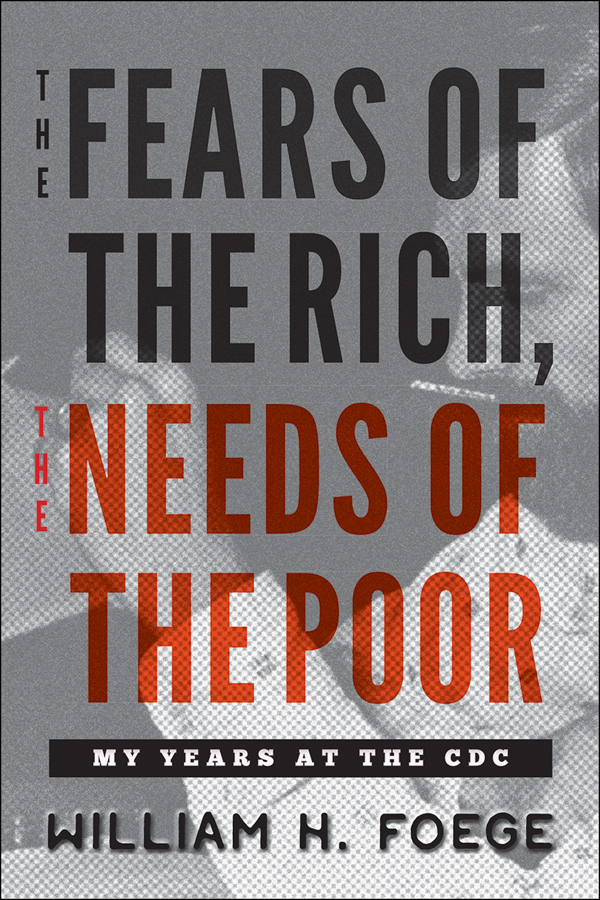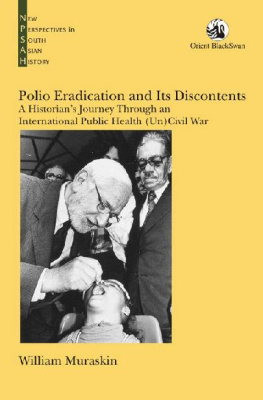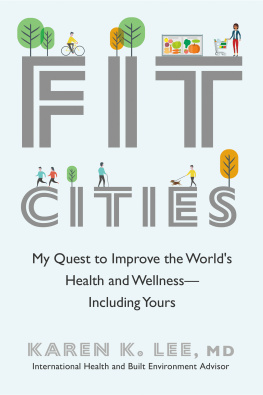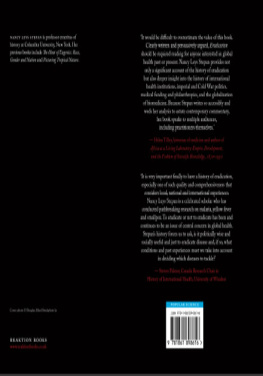Contents
Guide

FEARS OF THE RICH,
NEEDS OF THE POOR
My Years at the CDC
WILLIAM H. FOEGE
Johns Hopkins University Press | Baltimore
THE FEARS OF THE RICH, THE NEEDS OF THE POOR
THE FEARS OF THE RICH, THE NEEDS OF THE POOR
2018 Johns Hopkins University Press
All rights reserved. Published 2018
Printed in the United States of America on acid-free paper
9 8 7 6 5 4 3 2 1
Johns Hopkins University Press
2715 North Charles Street
Baltimore, Maryland 21218-4363
www.press.jhu.edu
Library of Congress Cataloging-in-Publication Data
Names: Foege, William H., 1936 author.
Title: The fears of the rich, The needs of the poor : my years at the CDC / William H. Foege.
Description: Baltimore : Johns Hopkins University Press, [2018] | Includes bibliographical references and index.
Identifiers: LCCN 2017035213| ISBN 9781421425290 (hardcover : alk. paper) | ISBN 1421425297 (hardcover : alk. paper) | ISBN 9781421425306 (electronic) | ISBN 1421425300 (electronic)
Subjects: | MESH: Foege, William H., 1936 | Centers for Disease Control and Prevention (US) | Public Health Administration | Public Health Practice | Communicable Disease Control | United States Government Agencies | United States | Personal Narratives
Classification: LCC RA425 | NLM WA 540 AA1 | DDC 362.1dc23
LC record available athttps://lccn.loc.gov/2017035213
A catalog record for this book is available from the British Library.
Special discounts are available for bulk purchases of this book. For more information, please contact Special Sales at 4106936 or specialsales@press.jhu.edu.
Johns Hopkins University Press uses environmentally friendly book materials, including recycled text paper that is composed of at least 30 percent post-consumer waste, whenever possible.
For Paula, David, Michael, Robert, Max, Ella, Olyana, and Erika
CONTENTS
PREFACE
Modern public health can be traced to May 14, 1796, when Edward Jenner inoculated a young boy, James Phipps, with cowpox material taken from a sore on the hand of Sarah Nelmes, a milkmaid infected with cowpox. Jenner was trying to mimic nature. He had observed that milkmaids appeared to be protected from smallpox disease. A subsequent attempt to infect Phipps with smallpox was unsuccessful. The boy had been protected by the cowpox inoculation.
Although many references to prevention and public health are found in both biblical and other historic writings, Jenners success marked the first time an actual tool was available to improve individual health and the health of people in the aggregate. Modern public health was now possible.
Linking public health, and specifically the Centers for Disease Control and Prevention (CDC), to Jenners work is an acknowledgment of our debt to that event. The CDC originally focused on communicable diseases, and immunizations and vaccines continue to be the foundation of public health. But the field has been expanded in one lifetime to encompass occupational hazards, environmental problems, intentional and unintentional injuries, chronic diseases, and mental health. The mission now embraces all types of barriers to healthbiological, chemical, behavioral, violent, and environmentaland recognizes positive ways to enhance quality of life.
I have been a list keeper throughout my life, keeping track of countries visited, trips taken, books read, quotations recalled, and lessons learned. Over the years, I have been intrigued by mentors I have never met, except through reading, and I have tried to divine what advice they might have had for me at different junctures in my life. Many of these influences, in one form or another, made it into this book.
This book is not a history of the CDC nor is it a history of public health or the breadth of CDC activities. It is a collection of stories. By telling these stories, I hope to illuminate the roles that, thanks to the CDC, my colleagues and I played at important moments in the history of global health and to reveal some of the lessons learned along the way.
chapter 1
A THREAT
My assistant entered the office, handed me a letter, and said, You had better read this before you do anything else. The writer informed me that he or she could deposit, undetected, botulinum toxin in a city water supply. This toxin is one of the most lethal agents known: a single teaspoon can kill millions of people. This was serious business. The writer provided sufficient detail to indicate he knew the subject well. He would be willing to negotiate if I would put an ad in the personals section of the New York Times with the message provided by the writer. I called the Federal Bureau of Investigation (FBI).
This threatening letter was one of many letters addressed to the director of the Centers for Disease Control (CDC) and received every day in the CDC front office. If left to me, it might have taken days before I would have opened it. But we had a system: my assistant, Carol Walters, opened every letter and logged them in to be sure they received attention and got answered. Carol had taken this letter from the pile and brought it to me. She was alarmed.
Botulinum toxin, an extremely toxic protein, is produced by a bacterium called Clostridium botulinum . The bacterium stays viable for long periods by encapsulating into a spore. It can grow only in an oxygen-deprived environment. Food poisoning, long feared in home-canned products, results from inadequate heating after jars are sealed, which allows spores to begin to grow in the canned food. The bacterium then produces a toxin, which has a devastating effect on the person eating that food. The toxin blocks the release of acetylcholine in muscles, which prevents the muscles from contracting. People die because they cannot breathe when the chest muscles become paralyzed.
We may have lost some of the fear of this toxin for two reasons. Home-canned food is less common now. Moreover, we use a diluted injectable form of botulinum toxin, or BOTOX, as a cosmetic aid that paralyzes small muscles that cause the wrinkles of aging. (When diluted, botulinum toxins toxicity can be restricted to certain muscles.) Its easy to forget how toxic the substance can be.
The FBI questioned CDC botulism experts, out of prudence, but also to determine the letter writers level of expertise. Some of the letters language included recent findings, an indication that the writer was an expert in the field or at least aware of recent literature. The FBI took the threat seriously. Federal agents took the letter for analysis. As with any homicide investigation, detectives must first rule out those closest to the victim. We had to ask whether any of our experts could be involved. After our suspicions were allayed, the FBI arranged to place the classified ad as instructed by the letter writer.
A second letter followed the classified ads publication; it contained additional details of the writers plan and a request for a second classified ad in the New York Times . The FBI continued their analyses and began to focus on an area in Florida as the source of the letters. The agency had been able to determine the brand of typewriter used and had hopes of finding the writer. Another letter might provide the breakthrough the FBI needed.






